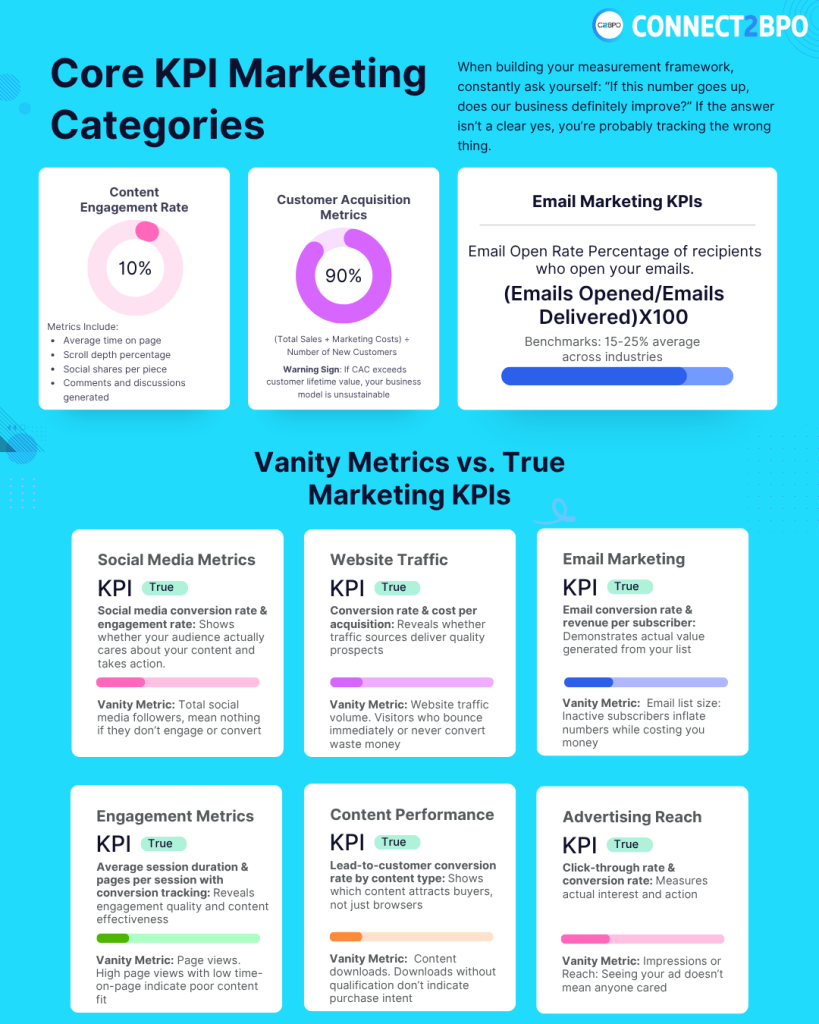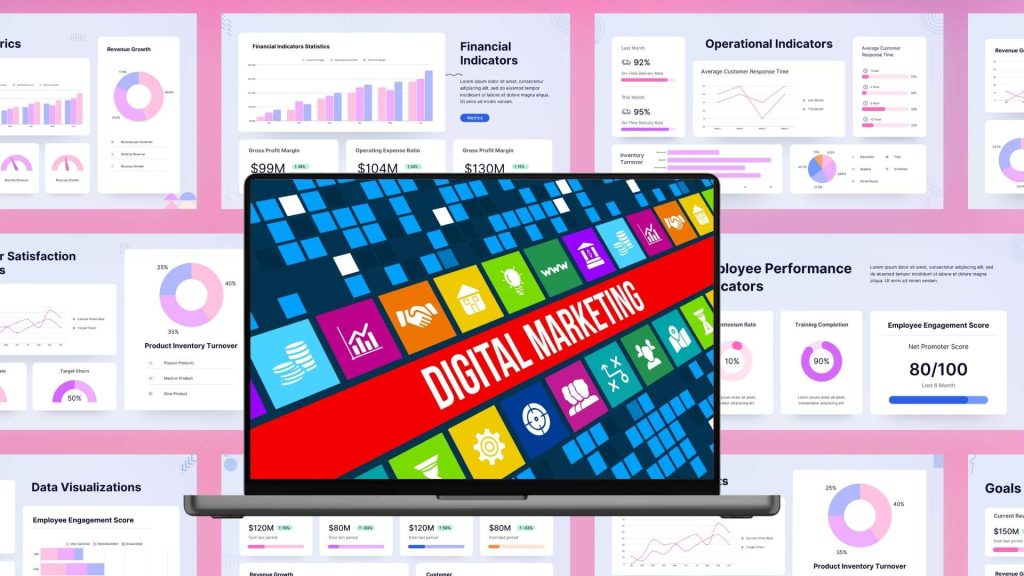Sarah, the CMO of a growing SaaS company, confidently presented her Q3 marketing report: “We posted 150 times on social media, sent 40 email campaigns, and our website traffic increased 35%!” The CEO paused and asked a simple question: “That’s great activity, but how many customers did we acquire, and what did they cost us?”
Sarah realized she had been measuring marketing activity, not marketing results. After implementing proper KPI marketing tracking, the picture became clear—and troubling. Despite all that activity, their customer acquisition cost had increased by 42%, only 8% of leads were sales-qualified, and their marketing ROI was negative 15%. However, this clarity enabled action. Six months later, by focusing on the right marketing KPI metrics, they reduced acquisition costs by 38%, increased qualified leads by 165%, and achieved a 340% marketing ROI.
This comprehensive guide explores what is KPI in marketing, provides essential KPI in digital marketing frameworks, and shows you how to build a marketing KPI dashboard that drives measurable business results instead of just tracking vanity metrics.
What Is a KPI in Marketing?
What is a KPI marketing metric, exactly? A marketing Key Performance Indicator is a quantifiable measurement that evaluates how effectively your marketing efforts achieve specific business objectives. Unlike general marketing metrics that simply track activity, KPI’s marketing focus on outcomes that directly impact revenue, growth, and profitability.
The distinction is crucial:
- Marketing Metrics: Website visits, email opens, social media followers
- Marketing KPIs: Customer acquisition cost, conversion rate, marketing ROI
Marketing KPIs serve several critical functions:
- Connect marketing activities to revenue outcomes
- Enable data-driven budget allocation decisions
- Identify which channels and campaigns drive real results
- Demonstrate marketing’s contribution to business growth
- Guide strategic adjustments based on performance data
Understanding KPI in Marketing vs. Vanity Metrics
This distinction is perhaps the most critical concept in modern marketing measurement. Too many marketing teams fall into the trap of reporting impressive-looking numbers that have zero correlation with business success. Your executive team doesn’t care if you have 50,000 social media followers if none of them become customers. They don’t care if your blog gets 100,000 monthly visitors if those visitors never convert. Understanding the difference between vanity metrics and true KPI in marketing is what separates amateur marketers from strategic business partners.
Vanity metrics make you feel good in the short term but lead to poor decisions and wasted budgets. True marketing KPIs might reveal uncomfortable truths, but they enable you to optimize, improve, and ultimately drive real business growth.

Vanity Metrics vs. True Marketing KPIs: The Critical Differences
Social Media Metrics
- ❌ Vanity Metric: Total social media followers – Large follower counts mean nothing if they don’t engage or convert
- ✅ True KPI: Social media conversion rate & engagement rate – Shows whether your audience actually cares about your content and takes action
Website Traffic
- ❌ Vanity Metric: Website traffic volume – Visitors who bounce immediately or never convert waste money
- ✅ True KPI: Conversion rate & cost per acquisition – Reveals whether traffic sources deliver quality prospects
Email Marketing
- ❌ Vanity Metric: Email list size – Inactive subscribers inflate numbers while costing you money
- ✅ True KPI: Email conversion rate & revenue per subscriber – Demonstrates actual value generated from your list
Content Performance
- ❌ Vanity Metric: Content downloads – Downloads without qualification don’t indicate purchase intent
- ✅ True KPI: Lead-to-customer conversion rate by content type – Shows which content attracts buyers, not just browsers
Engagement Metrics
- ❌ Vanity Metric: Page views – High page views with low time-on-page indicate poor content fit
- ✅ True KPI: Average session duration & pages per session with conversion tracking – Reveals engagement quality and content effectiveness
Advertising Reach
- ❌ Vanity Metric: Impressions/Reach – Seeing your ad doesn’t mean anyone cared
- ✅ True KPI: Click-through rate & conversion rate – Measures actual interest and action
The fundamental difference comes down to this: marketing KPIs directly connect to business outcomes and financial performance. If a metric doesn’t help you make better marketing decisions or can’t be tied to revenue impact, it’s a vanity metric masquerading as a KPI. When building your measurement framework, constantly ask yourself: “If this number goes up, does our business definitely improve?” If the answer isn’t a clear yes, you’re probably tracking the wrong thing.
Core KPI Marketing Categories
1. Lead Generation and Acquisition Metrics
Marketing Qualified Leads (MQLs) The number of leads that meet your defined criteria for sales-readiness based on engagement and fit.
Why it matters: MQLs bridge the gap between marketing activity and sales opportunities, showing whether your campaigns attract the right prospects.
Qualification Criteria Examples:
- Specific job titles or company sizes
- Engagement threshold (email opens, content downloads, website visits)
- Budget and timeline indicators
- Product fit signals
Cost Per Lead (CPL) The average amount spent to acquire one new lead.
📊 Formula: Total Marketing Spend ÷ Number of Leads Generated
🎯 Application: Compare CPL across channels to optimize budget allocation
Lead-to-Customer Conversion Rate Percentage of leads that ultimately become paying customers.
📊 Formula: (New Customers ÷ Total Leads Generated) × 100
💰 Impact: A 10% improvement in conversion rate can double profitability without increasing marketing spend
2. Customer Acquisition Metrics
Customer Acquisition Cost (CAC) Perhaps the most critical KPI for marketing, CAC measures the total cost of acquiring one new customer.
📊 Formula: (Total Sales + Marketing Costs) ÷ Number of New Customers
⚠️ Warning Sign: If CAC exceeds customer lifetime value, your business model is unsustainable
CAC Payback Period How long it takes to recover the cost of acquiring a customer through their revenue.
📊 Formula: CAC ÷ (Monthly Recurring Revenue per Customer × Gross Margin %)
🎯 Target: Most SaaS companies aim for 12 months or less
Marketing Originated Customer % What percentage of new customers came from marketing-generated leads versus sales prospecting.
💡 Strategic Value: Shows whether marketing truly drives growth or just supports sales-originated opportunities
3. Revenue and ROI Metrics
Marketing Return on Investment (ROI) The ultimate measure of marketing effectiveness—how much revenue marketing generates relative to its cost.
📊 Formula: ((Revenue from Marketing – Marketing Cost) ÷ Marketing Cost) × 100
🎯 Benchmark: 5:1 ratio (500% ROI) is considered good; 10:1 is exceptional
Marketing-Influenced Revenue Total revenue from deals where marketing played any role in the customer journey.
💡 Attribution Note: Use multi-touch attribution models to accurately credit marketing’s contribution across the buyer journey
Customer Lifetime Value (CLV) The total revenue a customer generates throughout their relationship with your company.
📊 Formula: (Average Purchase Value × Purchase Frequency × Customer Lifespan)
📈 Strategic Use: CLV ÷ CAC ratio should be at least 3:1 for healthy unit economics
4. Digital Marketing KPI Essentials
Understanding KPI in digital marketing requires tracking performance across multiple online channels and touchpoints.
Website Conversion Rate Percentage of website visitors who complete a desired action.
📊 Formula: (Conversions ÷ Total Visitors) × 100
🎯 Typical Ranges:
- B2B websites: 2-5%
- E-commerce: 1-3%
- Landing pages: 5-15%
Click-Through Rate (CTR) Percentage of people who click on your marketing content after seeing it.
📊 Formula: (Clicks ÷ Impressions) × 100
📊 Benchmarks by Channel:
- Email marketing: 2-5%
- Google Ads: 3-5% (search), 0.5% (display)
- Social media ads: 0.9-1.5%
Cost Per Click (CPC) Average amount paid for each click in paid advertising campaigns.
💡 Optimization: Lower CPC while maintaining quality scores improves overall campaign efficiency
Organic Search Traffic Growth Year-over-year increase in visitors from search engines.
📊 Measurement: Compare monthly organic traffic to same period previous year
💰 Value: Organic traffic has zero direct cost per click, making it highly profitable at scale
Channel-Specific Marketing KPIs
1. Content Marketing KPIs
Content Engagement Rate How actively your audience interacts with your content.
Metrics Include:
- Average time on page
- Scroll depth percentage
- Social shares per piece
- Comments and discussions generated
Content-to-Lead Conversion Rate Percentage of content consumers who become identified leads.
📊 Formula: (Leads Generated from Content ÷ Content Consumers) × 100
🎯 Optimization: Test different CTAs, content formats, and gating strategies
SEO Keyword Rankings Position of your target keywords in search engine results.
💡 Focus: Track rankings for high-intent keywords that drive conversions, not just high-volume terms
2. Email Marketing KPIs
Email Open Rate Percentage of recipients who open your emails.
📊 Formula: (Emails Opened ÷ Emails Delivered) × 100
📊 Benchmarks: 15-25% average across industries
Click-to-Open Rate (CTOR) Of those who opened your email, what percentage clicked a link.
📊 Formula: (Unique Clicks ÷ Unique Opens) × 100
💡 Advantage: CTOR is more reliable than CTR because it’s not influenced by deliverability issues
Email Conversion Rate Percentage of email recipients who complete the desired action.
📊 Formula: (Email-Driven Conversions ÷ Emails Delivered) × 100
🎯 Target: 1-5% depending on offer type and audience segment
3. Social Media Marketing KPIs
Engagement Rate How actively your audience interacts with your social content.
📊 Formula: (Likes + Comments + Shares + Saves) ÷ Total Followers × 100
📊 Benchmarks: 1-5% is typical; 5%+ is excellent
Social Media Conversion Rate Percentage of social media traffic that converts to leads or customers.
💡 Reality Check: Social media often has lower conversion rates than search or email, but plays important roles in awareness and consideration stages
Cost Per Acquisition (Social) How much you spend on social media advertising to acquire one customer.
📊 Compare across platforms: Facebook, LinkedIn, Instagram, Twitter each have different CPA benchmarks based on audience and ad format
4. Paid Advertising KPIs
Quality Score (Google Ads) Google’s rating of your ad relevance and landing page experience.
📊 Scale: 1-10, with 7+ considered good
💰 Impact: Higher quality scores reduce cost per click and improve ad position
Return on Ad Spend (ROAS) Revenue generated for every dollar spent on advertising.
📊 Formula: Revenue from Ads ÷ Ad Spend
🎯 Target: Minimum 4:1 (400% return); exceptional performers achieve 10:1+
Impression Share Percentage of available impressions your ads actually receive.
💡 Strategic Use: Low impression share indicates missed opportunities; analyze whether it’s due to budget constraints or low quality scores
Building Your Marketing KPI Dashboard
A well-designed marketing KPI dashboard provides at-a-glance visibility into marketing performance while enabling deeper analysis when needed.
Dashboard Design Principles
Hierarchy of Information Structure your dashboard to match decision-making levels:
Executive Dashboard (5-7 metrics):
- Marketing ROI
- Customer Acquisition Cost
- Marketing-Influenced Revenue
- Lead-to-Customer Conversion Rate
- Customer Lifetime Value
Marketing Director Dashboard (12-15 metrics):
- All executive metrics plus:
- Channel-specific CAC
- MQL generation and quality
- Campaign performance comparisons
- Budget pacing and efficiency
Channel Manager Dashboard (20+ metrics):
- Detailed channel-specific performance
- Campaign-level metrics
- A/B test results
- Real-time optimization opportunities
Essential Dashboard Components
Trend Visualization Don’t just show current numbers—display performance trends over time to identify patterns and momentum.
Comparative Analysis Include benchmarks and targets alongside actual performance:
- Current vs. target
- Current period vs. previous period
- Channel A vs. Channel B performance
Alert Systems Configure notifications for critical KPI thresholds:
- CAC exceeding target by 15%+
- Conversion rates dropping below acceptable range
- Campaign budgets approaching limits with low performance
Data Integration Requirements
Multi-Source Data Consolidation Effective marketing dashboards integrate data from:
- CRM systems (Salesforce, HubSpot)
- Analytics platforms (Google Analytics, Adobe Analytics)
- Advertising platforms (Google Ads, Facebook Ads Manager)
- Marketing automation (Marketo, Pardot)
- Social media management tools
Implementation Strategy for Marketing KPIs
Define Business Objectives Your KPI marketing selection must start with clear business goals:
- Increase revenue by X%
- Reduce customer acquisition cost by Y%
- Expand into new market segments
- Improve customer retention
Audit Current Tracking Capabilities Assess your existing measurement infrastructure:
- What data is currently captured?
- Which systems need integration?
- Where are the data quality gaps?
- What technical capabilities need development?
Select Initial KPI Set Start with 10-15 core KPIs rather than trying to track everything:
2-3 efficiency/cost KPIs
3-5 high-level business outcome KPIs
5-7 channel performance KPIs
Implement Tracking Systems Ensure you can accurately measure selected KPIs:
- Install proper analytics tracking codes
- Set up conversion tracking across platforms
- Implement UTM parameter standards
- Configure CRM integration and data flow
Establish Baseline Metrics Before making changes, document current performance:
- Historical data analysis (6-12 months)
- Benchmark against industry standards
- Identify quick-win opportunities
Create Reporting Processes Develop standardized reporting cadence:
Quarterly: Strategic planning and budget allocation
Daily: Campaign monitoring for active initiatives
Weekly: Channel performance and optimization opportunities
Monthly: Comprehensive performance reviews
Continuous Testing and Learning Use your marketing KPI data to drive experimentation:
- A/B test messaging, offers, and creative
- Test different audience segments
- Optimize channel mix based on performance
- Refine targeting and bidding strategies
Regular KPI Review Quarterly assessment of whether you’re tracking the right metrics:
Should we add, remove, or modify any KPIs?
Are current KPIs aligned with evolving business priorities?
Do we have the data needed for important decisions?
Common Marketing KPI Pitfalls
Tracking Activity Instead of Outcomes The most common mistake: measuring marketing busyness rather than business impact.
❌ Wrong Focus: “We published 50 blog posts this quarter”
✅ Right Focus: “Blog content generated 500 MQLs at $45 per lead”
Attribution Complexity Paralysis Waiting for perfect attribution before taking action wastes opportunities.
Practical Approach: Start with simple last-touch attribution, then evolve to more sophisticated models as you gain experience and data volume.
Ignoring Lifetime Value Focusing solely on acquisition cost without considering customer value leads to poor decisions.
Example: Channel A costs $200/customer but generates $2,000 lifetime value. Channel B costs $100/customer but generates only $500 lifetime value. Channel A is the better investment despite higher upfront cost.
Siloed Channel Measurement Customers interact with multiple touchpoints before converting. Channel-specific KPIs without cross-channel view miss the complete picture.
Static Benchmarks Digital marketing evolves rapidly. Benchmarks from two years ago may be irrelevant today. Continuously update your performance targets.
Industry-Specific Marketing KPIs
E-commerce Marketing
Shopping Cart Abandonment Rate Percentage of started purchases not completed.
📊 Formula: (Abandoned Carts ÷ Initiated Checkouts) × 100
💡 Optimization: Test cart abandonment email sequences, checkout simplification, shipping offers
Average Order Value (AOV) Average amount spent per transaction.
📊 Formula: Total Revenue ÷ Number of Orders
💰 Growth Strategy: Increasing AOV by 10% has same revenue impact as increasing traffic by 10%, but at lower acquisition cost
Customer Repurchase Rate Percentage of customers who make repeat purchases.
📊 Formula: (Customers with 2+ Purchases ÷ Total Customers) × 100
🎯 Target: Varies by industry; monthly consumables should see 60%+, while durable goods may be 20-30%
B2C Service Business
Appointment Booking Rate Percentage of website visitors or ad clicks that schedule appointments.
Local Search Visibility Rankings and impression share for location-based searches.
Key Metrics:
- Google Business Profile views
- Direction requests
- Phone calls from search
Technology Solutions for Marketing KPI Tracking
All-in-One Marketing Platforms
Integrated platforms like HubSpot, Marketo, or Pardot provide:
- Built-in marketing KPI dashboard functionality
- Automated reporting across email, social, ads, and website
- CRM integration for closed-loop reporting
- Multi-touch attribution capabilities
Specialized Analytics Platforms
Google Analytics 4 Comprehensive website and app analytics with:
- Enhanced conversion tracking
- Cross-device user journey analysis
- Audience insights and segmentation
- Integration with Google Ads for unified reporting
Business Intelligence Tools Platforms like Tableau, Looker, or Power BI enable:
- Custom dashboard creation
- Multi-source data integration
- Advanced visualization options
- Automated reporting distribution
Attribution and Marketing Mix Modeling
Specialized solutions for understanding marketing impact:
- Multi-touch attribution platforms (Bizible, Dreamdata)
- Marketing mix modeling for long-term strategic insights
- Incrementality measurement tools
Future Trends in Marketing KPIs
Privacy-First Measurement
The death of third-party cookies and increasingly strict privacy regulations are fundamentally reshaping how marketers track performance. Cookie deprecation means traditional tracking methods are becoming obsolete, forcing a shift toward privacy-safe measurement approaches. First-party data strategies are no longer optional—they’re essential for survival. Companies that own direct relationships with their customers and collect data through consensual interactions will have massive advantages over those relying on third-party data. Server-side tracking is replacing pixel-based methods, offering more reliable data while respecting user privacy. Attribution models are evolving to work with aggregate, anonymized data rather than individual user tracking. This shift actually benefits sophisticated marketers who focus on incrementality and true business impact rather than last-click attribution.
AI-Powered Optimization
Artificial intelligence and machine learning are transforming how we use KPI in digital marketing data. Predictive lead scoring uses historical patterns to identify which prospects are most likely to convert, allowing marketers to prioritize high-value opportunities automatically. Automated budget allocation across channels happens in real-time based on performance data, shifting spend to what’s working and away from what’s not—faster than any human could manage. Real-time creative optimization tests and adapts messaging, images, and offers on the fly, personalizing experiences at scale. Anomaly detection systems monitor your marketing KPIs continuously and alert you the moment something unusual happens, whether it’s a sudden drop in conversion rates or an unexpected spike in cost per acquisition.
Unified Customer Data Platforms
Customer Data Platforms are becoming the central nervous system of marketing measurement. These systems consolidate customer data from every touchpoint—website visits, email interactions, purchase history, customer service contacts, social media engagement—into a single, unified customer view. This consolidation enables real-time segmentation and personalization based on complete customer understanding rather than fragmented data. Attribution accuracy improves dramatically when you can see the entire customer journey across all channels and devices. Most importantly, CDPs enable measurement of true customer journey effectiveness, showing not just which channels drive conversions, but how different touchpoints work together to move prospects through the buying process.
Conclusion
Effective KPI marketing measurement transforms marketing from a cost center to a predictable revenue engine. By focusing on metrics that directly connect to business outcomes, implementing robust tracking infrastructure, and consistently optimizing based on data insights, marketing teams can demonstrate clear value while continuously improving performance.
The key to success lies in selecting KPIs aligned with business objectives, building reliable measurement systems, avoiding vanity metrics, and maintaining focus on metrics that drive real decisions. Start with a core set of 10-15 KPIs, ensure you can accurately track them, and expand measurement capabilities as your sophistication grows.
Remember that the most impressive marketing KPI dashboard is only valuable if it enables better decisions and drives improved outcomes. Focus on actionable insights rather than comprehensive data collection, maintain alignment with sales and executive teams on what success looks like, and commit to continuous testing and optimization.
Ready to implement comprehensive KPI tracking across your entire organization? Learn about essential business metrics and measurement frameworks in our complete guide to Key Performance Indicators.



